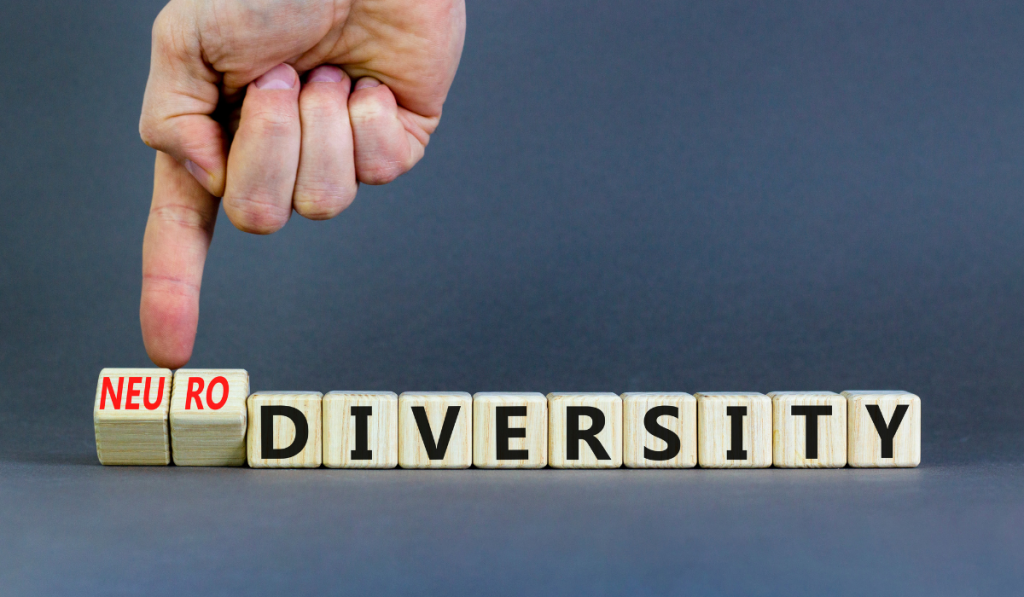Neurodiversity in the workplace is an essential aspect of modern business, as it fosters innovation and drives success by embracing the unique talents of neurodivergent employees. A diverse workforce that includes individuals with neurological differences such as autism spectrum disorders, attention deficit hyperactivity disorder, learning disabilities, and social anxiety disorders can lead to a more inclusive and supportive environment for all.
In this post, we’ll investigate different ways to incorporate neurodiversity into the office by recognizing its worth, honoring our disparities, and taking advantage of the talents of those with neurological differences. We’ll also discuss how partnering with an executive business coach can help you unlock your productivity and success while supporting a diverse team.
Finally, we’ll introduce Flanagan Leadership Group’s unique approach to coaching neurodivergent talent that combines emotional intelligence with practical strategies designed specifically for today’s fast-paced work environments. By implementing these ideas into your business’s culture and recruitment processes, you can create a thriving atmosphere where everyone has the chance to cultivate their abilities and give their all.
Embracing Neurodiversity in the Workplace
If you think your workplace is already diverse enough, think again. It’s time to go beyond race, gender, and age – let’s talk about neurodiversity.
Embracing neurodivergent people means understanding various neurological conditions (like attention deficit hyperactivity disorder, autism spectrum disorder, obsessive-compulsive disorder, or other neurodivergent conditions) and implementing policies that support employee well-being for all.
And who better to help you navigate this brave new world than an executive business coach from Flanagan Leadership Group? With our guidance, organizations can foster a truly diverse workforce that includes individuals from all walks of life.
1. Educating Leaders on Neurological Differences
First things first: education. It’s vital for leaders to comprehend the complexities of neurotypical people if we want to make any progress.
Rather than spending time researching conditions such as social anxiety and learning disabilities, why not tap into the expertise of experienced professionals at Flanagan Leadership Group to gain a better understanding of neurological diversity in the workplace and strategies for creating an accommodating atmosphere?
By working with coaches at Flanagan Leadership Group, you’ll gain valuable insights into how neurological differences impact work experience while also learning strategies for fostering a supportive environment.
Whether or not you’re ready to work with an experienced coach, it’s vital to become educated on neurological differences as well as what adaptations need to be made in the workplace to accommodate people with these differences. Here are a few simple adjustments you can start with:
Implementing Simple Adjustments for Sensory Sensitivities
- No more fluorescent lights flickering overhead like a rave gone wrong – switch to softer lighting options instead.
- Avoid sensory overload by offering noise-canceling headphones or designated quiet spaces where employees can retreat when needed.
- Create clear job descriptions so autistic people know exactly what’s expected of them without having to decipher cryptic corporate lingo.
Incorporating these changes may seem like small potatoes, but trust us – they can make a world of difference for neurodivergent employees, especially in the United States. And when your workforce is happy and productive, everyone wins.
Incorporating workplace accommodations for neurodiversity into the corporate setting can be a potent resource to promote invention and cultivate an atmosphere of acceptance for personnel. To further this goal, it’s also a good idea to rethink hiring practices so that they’re better suited for those with neurological differences.
Related: Reunion Grief and ADHD

2. Rethinking Hiring Practices for Neurodiverse Talent
Traditional interview processes are about as outdated as the fax machine. They’re not exactly designed to accurately assess the abilities of neurodivergent candidates, who might have unique skill sets that don’t shine through in a nerve-wracking, one-on-one interrogation session.
So, how can companies revamp their hiring practices to accommodate neurodiverse candidates? Fear not, we’ve got some ideas.
Adopting Alternative Assessment Methods like “Hangouts”
First, let’s ditch those stuffy interviews and adopt alternative assessment methods that would give a neurodivergent person a fair shot at showcasing their talents during the hiring process.
Enter “hangouts,” an ingenious method used by Specialisterne in Germany, where applicants engage with potential employers in casual settings (think coffee shops or parks) instead of formal office environments during the interview process. This allows candidates to demonstrate their skills more authentically while minimizing communication barriers caused by social anxiety disorders or autism spectrum conditions.
Here are some other solutions to accommodate neurodiverse candidates during the hiring process:
Leveraging Technology for Better Candidate Evaluation
- Talent Matching Software: Embrace technology and use talent matching software during screening processes to identify unique attributes among applicants without relying on conventional job descriptions riddled with buzzwords and jargon.
- Digital Portfolios: Encourage candidates to submit digital portfolios showcasing their work experience, accomplishments, and creative projects – because nothing says “I’m the perfect fit for this job” like a well-curated collection of achievements.
- Virtual Reality Assessments: Take it up a notch and incorporate virtual reality assessments to simulate real-life work environments, allowing candidates with learning disabilities or attention deficit hyperactivity disorder (ADHD) to demonstrate their problem-solving abilities in immersive settings.
By rethinking hiring practices and embracing neurodiverse people in the workplace, companies can tap into a virtually untapped pool of potential employees who bring unique perspectives, emotional intelligence, and innovative thinking.
So go ahead – shake things up in your recruitment process and watch your business flourish as you build skills within a diverse workforce. And if you need some guidance along the way, don’t hesitate to partner with an executive business coach from Flanagan Leadership Group. We’re here to help you find productivity and success through neurodiversity.
In short, rethinking hiring practices for neurodiverse talent is a crucial step in fostering an inclusive workplace. Plus, by creating a supportive environment for these employees, businesses can truly unlock the potential of this valuable population. By establishing mentorship programs and assigning work buddies, employers can also ensure that their neurodivergent staff have access to the resources they need to thrive.
3. Creating a Supportive Environment for Neurodivergent Employees
So, you’ve decided to embrace neurodiversity in your workplace. Good on you. But what’s next?
Well, it’s time to roll up those sleeves and create an environment where your neurodivergent employees can thrive like the superheroes they are.
Creating a stimulating workspace is essential, yet it’s only the beginning of building an environment that allows neurodivergent employees to reach their full potential. We mean implementing long-term strategies that cater specifically to their unique needs and create a safe space for them to thrive.
Establishing Mentorship Programs
Two brains are superior to a single one, right? Imagine pairing up mentors with mentees who have neurodiverse conditions like ADHD or autism spectrum disorders (ASD). It’s a match made in heaven.
Not only will this help them navigate the corporate jungle more efficiently, but it’ll also give them someone who understands their quirks and can guide them through any potential communication barriers or social anxiety issues. Plus, mentors get the opportunity to build skills in emotional intelligence – talk about a win-win.
Assigning Work Buddies
If mentorship programs sound too formal for your taste (we get it), why not try assigning work buddies instead? This is especially helpful for new hires who may need additional guidance navigating office politics due to their neurological differences. Just think of all those awkward water cooler conversations avoided by having someone show them the ropes from day one.
- Buddy Benefits: Increased job satisfaction among both parties as well as improved retention rates for neurodivergent employees.
- Pro Tip: Encourage buddies to have regular check-ins and provide constructive feedback, ensuring everyone’s on the same page.
In a world where cookie-cutter job descriptions are as outdated as fax machines, it’s time we start embracing our differences and creating work environments that cater to all types of minds. So go ahead – make your workplace more inclusive by establishing mentorship programs or assigning work buddies for your neurodiverse talent. Variety brings zest to life.
Of course, creating a supportive environment for neurodivergent employees is absolutely essential in fostering an inclusive workplace. Furthermore, businesses can create an atmosphere of acceptance and understanding by promoting team-building activities that encourage inclusivity.
Related: What is Neurodiversity?

4. Fostering Team-Building Activities That Promote Inclusivity
Let’s face it, team-building activities can be a hit or miss. But when done right, they’re the secret sauce to building an inclusive environment where everyone feels valued and appreciated – even those with neurological differences.
So, let’s dive into some tips on how to create fun-filled exercises that cater to all skill sets and communication styles.
Developing Inclusive Team-Building Exercises
Rather than relying on a generic, universal strategy, it’s essential to make sure that all neurodiverse staff members feel included and accepted. Instead of playing favorites with traditional icebreakers or games designed for extroverts only (cough cough, karaoke night), consider these options:
- Mystery-solving challenges: These are perfect for engaging problem-solvers who might have attention deficit hyperactivity disorder (ADHD) or autism spectrum disorders. Plus, who doesn’t love a good whodunit?
- Creative workshops: Artistic projects allow people with social anxiety disorders or learning disabilities to express themselves in ways that words sometimes can’t capture.
- Innovation sessions: Brainstorming new ideas is not only great for business but also helps build skills among neurodivergent individuals by tapping into their unique perspectives.
Encouraging Open Communication Between Team Members
A little birdie once said that communication is key – and we couldn’t agree more. To break down any potential barriers between your neurodiverse workforce, consider implementing the following strategies:
- Anonymous feedback channels: Not everyone is comfortable voicing their opinions in person. Creating an environment where personnel can express their views without apprehension of criticism could have a beneficial impact.
- Cultural sensitivity training: Educate your team on different communication styles and neurological differences so they can better understand and support neurodivergent colleagues. After all, knowledge is power.
- Mindful meetings: Encourage active listening during discussions by setting ground rules that promote respect and empathy among participants – because nobody likes being talked over or ignored.
Incorporating these tips into your team-building activities will not only help create an inclusive environment but also foster emotional intelligence within your workforce. And if you’re still unsure about how to go about it, partnering with an executive business coach like our coaches at Flanagan Leadership Group might just be the secret ingredient you need to find productivity and success.
By fostering team-building activities that promote inclusivity, organizations can create an environment where neurodiverse individuals feel comfortable and accepted. With this understanding of how to foster a more inclusive workplace, we can now look at successful examples of integrating neurodiverse workforce into the corporate world.
Related: How Do I Become a Successful Business Owner with ADHD?
Successful Examples of Integrating Neurodiverse Workforce
If you’re still skeptical about the benefits of building a neurodiverse workplace, let’s take a look at some organizations that have already taken the plunge and are reaping measurable financial and cultural rewards. These trailblazers prove that hiring neurodivergent workers is not just an act of charity or corporate social responsibility; it’s a smart business move.
Australian Defense Department partnering with HPE
The Australian Defense Department has been partnering with Hewlett Packard Enterprise (HPE) to employ neurodivergent adults in various roles within their organization for quite awhile now. This collaboration seeks to both provide employment for those on the autism spectrum and benefit from their distinctive aptitudes, such as a penchant for meticulousness and capacity to recognize patterns. Talk about hitting two birds with one stone!
Specialisterne’s “Hangouts” in Germany
In Germany, Specialisterne – a company specializing in recruiting and supporting autistic employees – introduced an innovative approach called “hangouts” during their recruitment process. Like we previously mentioned, instead of traditional interviews which can be intimidating for autistic candidates, these hangouts provide potential hires with comfortable environments where they can showcase their skills through practical tasks related to the job description.
By implementing alternative hiring processes like this, companies can gain valuable insights into how well-suited each candidate is for specific roles without relying solely on interview performances.
These examples demonstrate that adopting inclusive practices like alternative assessment methods or leveraging technology isn’t just good PR; it leads to tangible benefits for businesses.
So, why not follow in the footsteps of these forward-thinking organizations and partner with an executive business coach from Flanagan Leadership Group to unlock your company’s full potential by embracing neurodiversity?
In case you still have questions, here are a few questions people often ask:
Frequently Asked Questions About Neurodiversity in the Workplace
What are neurodiversity issues in the workplace?
Neurodiversity issues in the workplace refer to challenges faced by individuals with neurological differences, such as autism, ADHD, dyslexia, and others. These may include difficulties with communication, social interactions, executive functioning or sensory processing. Employers need to be aware of these potential barriers and implement strategies for creating an inclusive work environment that supports all employees.
Why is neurodiversity important in the workplace?
Embracing neurodiversity is crucial because it fosters a diverse workforce that brings unique perspectives and skills. A more inclusive work environment can lead to increased innovation, productivity and employee satisfaction. Additionally, supporting neurodiverse employees demonstrates corporate responsibility and helps companies attract top talent while reducing turnover rates.
How can neurodiversity be supported in the workplace?
To support neurodiverse employees effectively, companies can:
- Create awareness about different neurological conditions
- Promote open communication between team members
- Provide reasonable accommodations tailored to individual needs
- Incorporate flexible working arrangements when possible
- Foster a culture of acceptance through training programs on diversity and inclusion
Conclusion
Neurodiversity in the workplace can be a challenge, but with the right education and coaching it definitely doesn’t have to be.
At Flanagan Leadership Group, we provide innovative tools and resources that empower neurodiverse individuals to unlock their productivity and success. We also help businesses make the transition to a neurodiverse workplace, and we would love to help you transform your company into an environment that’s supportive for employees in all walks of life.
Don’t let your unique skills or the unique skills of your employees go unnoticed – partner with us today for an empowering journey of growth.
Take the first step to achieving success in your career by discovering how neurodiversity can benefit you and your organization. Unlock the potential of neurodiverse individuals with Flanagan Leadership Group’s tailored coaching services today.


